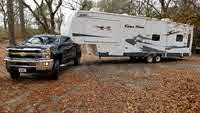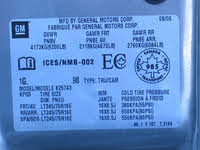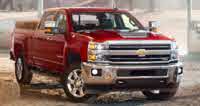fifth wheel hitch wt
Asked by medicork Jul 22, 2018 at 01:45 PM about the 2005 Chevrolet Silverado 2500HD
Question type: General
I have a 2005 Chevy 2500HD duramax with Allison transmission.
My fifth wheel hitch is rated for 18,000lbs, how much hitch wt can I have
without having to put on airbags?
The Fifth wheel trailer tongue wt is around 1580lbs
4 Answers
13,600 lb. You should have that information in your owner's manual. Air bags only level your load so spend the money and add them to your truck so you don't blind people coming the other way. Good Luck!
My answer isn't quite correct. 13,600 is the max 5th wheel you can tow with a 2500 HD with the Duramax and Allison. you could have saved some money and put a 15,000 lb. fifth wheel in your truck. Even though you have a 18,000 lb. hitch you can only legally pull 13,600 lb. your truck can only pull 13000 on a ball hitch. I have a 2015 2500HD Duramax with the six speed Allison. My weight ratings are the same. I pull a 39 ft. 2007 Pilgrim Open Road that weighs 11600 lb. I blind people if I drive at night. Getting air bags soon. the 3500 has some extra springs above the leaf springs in the opposite direction. You can put those on your truck and increase the load in the bed but your truck wasn't designed for the extra weight. If you get in an accident and they find you have too much weight on your truck you will be found at fault and or fined. That is what you need to be concerned with. See you out there!
Skeetersaurus answered 2 years ago
Quite late to the response on this, but for others that might be reading it for their own application, here's the 'long form' answer: On your door jamb, your SPECIFIC vehicle will have a data plate (or sticker) that lists a bunch of information...tire size, relative tire pressure (applicable ONLY to the OEM tire that came on the truck), GAWR (Gross Axle Weight Rating), GVWR (Gross Vehicle Weight Rating) and GCWR (Gross Combined Weight Rating). Of all these, those who tow trailers, or (especially) those who use drop-in truck campers, need to be 'relative experts' on what these last three numbers actually are, and how they apply. My personal 'towing vehicle' is a Chevrolet 2500HD Silverado...but it's not your 'off the lot' kind of truck. It was specially ordered, with just about every 'bell-and-whistle' that you could opt that year for 'heavy towing'...except the diesel. This was a personal choice based on 'operation costs'...and a few hundred pounds of payload gained by going 'gas' over 'diesel'. My SRW (Single Rear Wheel) truck has a 'wet weight' (gas, oil, etc.) of 5,270-pounds. OEM says 5,300 on their data sheet...close enough. MAX GVWR for this truck is 9,200-lbs (all 3/4- ton trucks come in under 10,000-lbs, it seems, to get around various state licensing issues with that 'magic number'). Even though it has a Corporate 14-bolt rear axle...the same that comes under the similar 1-ton 3500-series (rated at 12,700-lbs GVWR), it's 'down-rated' due to the tires (NHTSA and FMVSS are funny about justifying 'downrating' without a real reason)...so, knowing it's the same axle means I KNOW there is a 'non-spoken safety margin' there for me...then again, D.O.T. isn't going to stop writing that ticket if they portable-scale me on I-40 and I weigh 11,000-lbs with 9,000-lbs on that rear axle...I'm getting a ticket, period. LESSON 1: YOU MUST ALWAYS STAY UNDER your GAWR, GVWR and GCWR values! The 2500HD is a very 'balanced' truck...52/48 weight distribution (front/rear)...yet the GAWR's are not...the rear axle is rated with a higher capacity than the front...then again, makes sense...it's really hard to 'add forward load' to a pickup...you can only do this by putting payload in-between the span seperating the rear axle and the front bumper...load behind the rear axle, you throw it all on the rear axle (and, inadvertently, remove weight from the front axle...simple 'see-saw' effect). A fifth wheel mounts FORWARD of the rear axle, normally 5-8 inches or so, so that 95% or so, of your mount loading goes DIRECTLY onto the rear axle. So, back to the example: The GAWR's sum to the GVWR...WITH EXCEPTIONS! You'd think, 'ok...GVWR is 9,200- lbs...so if the front axle is rated to 4,600-lbs, then the rear MUST also be 4,600-lbs...so they can add up to 9,200-lbs?! NOPE! A PRIME EXAMPLE OF THIS is my own truck...a K-code (6.0-liter Vortec)...front axle (on my data plate) says GAWR FRONT is 4,670-lbs...and the rear GAWR is 6,084-lbs! That doesn't add up, you say! How can this be? Well...this has happened quite a bit throughout the history of trucks...where all axle GAWR's sum to more than the GVWR...even though, they shouldn't. So...you, as the owner...and more importantly, as the tow-driver (who sees those D.O.T. blue lights when they think you're 'heavy') are responsible for understanding...you NOW have TWO NUMBERS to meet! First, you cannot exceed your GVWR (in my case, 9,200-lbs), but you ALSO cannot exceed your rear GAWR (6,084-lbs). Violating EITHER will result in a hefty ticket (that they are enforcing more now, than ever before...some in part, due to hotshot drivers trying to use Class-D licenses to conduct commercial driving with light-duty trucks. Ok...having put my truck on a scale, I know that my actual truck weighs in, per axle, Front: 2740-lbs and Rear: 2530-lbs. wet and empty of payload. So, my front axle offers an available payload of 1,940-lbs, and my rear axle offers an available payload of 3,518-lbs. (GAWR - Actual scale weight = Available Payload). HOWEVER...remember how I mentioned that fifth wheel mount going almost over-top of your rear axle, and that putting all the mount weight on your REAR axle (only)? Yeah...here's the thing that bites most who get weight tickets...you're going to consume ALL that available payload on the rear axle, and never find a way to move or 'shift' that weight forward, to 'share it' with that available front axle payload availability. Some 'tag' (bumper mount) trailers take advantage of something called a 'load distributing hitch', which uses chains and straight-bars to actually 'tie' the trailer weight into the truck frame...and accomplish just this. HOWEVER, Fifth wheels, goosenecks and drop-in campers are out of luck...no such creature to help you. So...in my case, you have a truck...you bought a 3/4-ton HD, which is actually a 1-ton (for all purposes), that IS CAPABLE of carrying 3,500-lbs of payload. HEY, NOT BAD AT ALL! But...we all get greedy, and 'want more'...well...it is unfortunate to say, there's nothing past that. If you get 'scaled', you MAY be able to shift your fifth wheel forward (if you have a shiftable fifth wheel) and try to get 100-300 lbs off that hitch...but if you're trying to get another 2,000-3,000-lbs of carry-capacity? FORGET IT! You've got the wrong truck. As another poster said, 'airbags are to level your load, as long as it is within allowable cargo capacities'...they are merely leveling devices...though I'd hazard to say that most of us have used them 'inappropriately' (I have a set of Airlift 5k airbags on my truck...and when I say, 'I've got a 5-ton truck right there', I almost mean it)...can the rear axle take it? Yep. Can D.O.T. take my money, if they catch me? YEP! Now...one thing that MOST aren't paying attention to, when they consider 5th wheel hitches...is that catchy name '15k PRO', '18k SERIES', '30k MAMMOTH', etc...well, guess what? Read that data in the owners manual on that hitch you just bought. It may be able to TOW 15,000-lbs, or 18,000-lbs or even 30,000-lbs...but you better see what that 'maximum downweight' it can take. I know FOR A FACT that the 15,000-lb fifth wheels (won't call a name brand here) is ONLY RATED to 2,700-lbs DOWN WEIGHT! So, in reality, I'm overloading the hitch before I even get to my truck's GVWR or rear GAWR! Now, I'm walking on eggshells, and traveling DANGEROUSLY! GCWR is a SERIOUS consideration for ANY trailer tow'er. GCWR is your COMBINED weight of truck and trailer. I've got an 11,900-lb 5th wheel...my truck's 5,270-lbs...that's 17k-lbs! Insanity is trying to pull this combo with a 15k-hitch! My downweight is 2,900-lbs! (the 15k hitch is only rated MAX to 2,700-lbs or so)...so, of course, I have a 20k hitch...because the math tells me I have to! One last point...and that is 'tow ratings' on our trucks. Know what happens, when you option out a HD truck to 'extra heavy towing'? Your pricetag turns into an Apollo rocket! Oil Cooler, Trans Cooler, Extra large brakes, trailer braking package, etc. Yep...and on top of that...mine actually caused ANOTHER TRANSMISSION to be required! A rather-rare 6L90E GM transmission (basically, the GM-built version of the Allison 1000 they put behind Duramax Diesels). My towing package cost an extra $4,800! Now...why do all this, you might ask? Simple...the 'Big 3' are pretty smart when it comes to warranty claims...and they don't want to be 'gifting me' a new transmission every month...only to have a ticked-off customer in the end, who won't buy their product again (due to all the failures)...so that GVWR/GCWR issue? Yep...it's tied to WARRANTY CLAIMS!!! See, it's NOT your engine that really catches grief in towing...it's hard, it's lugging...somewhat, but the thing that's getting COMPLETELY COOKED when pulling 10-tons up a mountainside highway...is the TRANSMISSION! By nature of the beast, automatic transmissions are hydraulic pumps turning friction into heat and dissipating it to do it again. If you tried to do with a stock 700R4, what I can easily do with that 6L90E, it would eat that 700R4 transmission in minutes. Now, that Allison 1000? Hey, tomato, tomatoe...pretty much same HD beast. So...when you get to saying 'how much airbag do I need?' in reality, you've opened up a whole can of worms...because you have now said 'I am actually working this truck beyond the amount of springs they gave me'...which then drives a bunch of other questions, like: How much payload do I really have? Do I need to fill my gas tank up and run this thing across a scale for some accurate readings? Is that front winch and winch bumper costing me payload, or helping me? Are my suspension and driveline components up to par? Do I have heavy- enough transmission to do what I want to do? Do I have the correct hitch for the job? Is my complete GCWR going to require me to have a commercial (or in some states like Texas, a 'non-commercial class-A' ) license? Again...air bags are, in my opinion, FAR BETTER (LOVE Airlift Airbags...they make an EXCELLENT OEM-Quality Airbag system) than any 're-stack of springs' or 'add-a-leaf' shadetree solution you would otherwise implement...and if you are running A GM-14-bolt or heavier rear axle, then they make a great combination for ride-quality and 'dial-it-in smoothness'....BUT...if you are trying to really get 5,000-lbs of LIFT from them, then my first reply would be 'you need a heavier truck'...a consideration few take into account. The other side of this, is quite simple: Go to a local 'medium duty truck sale paper' or Craigslist, etc., and price out a Class-5 truck, maybe just a cab-on-chassis. You can find EXCELLENT used Class 5 trucks, often used by corporations for 'utility use' that no longer have their bed (it was removed to used on their new incoming models)...just drop a flatbed on it, put your rails on it, FORGET all that suspension work, and tow-with it. I've bought NICE Class-5's used before for less than $7,000 and for the sake of a brake job or a couple of tires, gotten 100k miles out of them! Towing 15k-lbs behind a class 5 is like towing a golf cart behind a half-ton! (and a class-5 is below the 28k-lb limit that mandates a commercial license...just tag it as an 'RV' and be done!)


